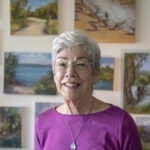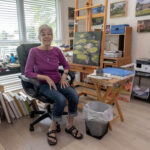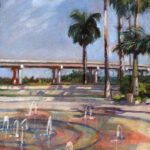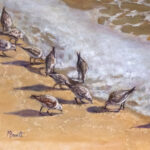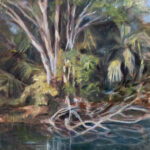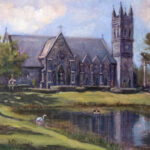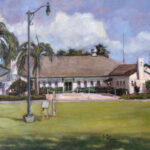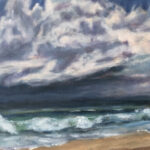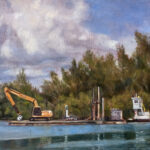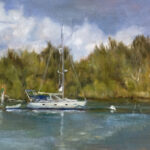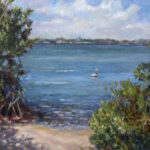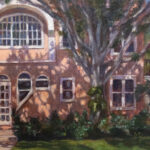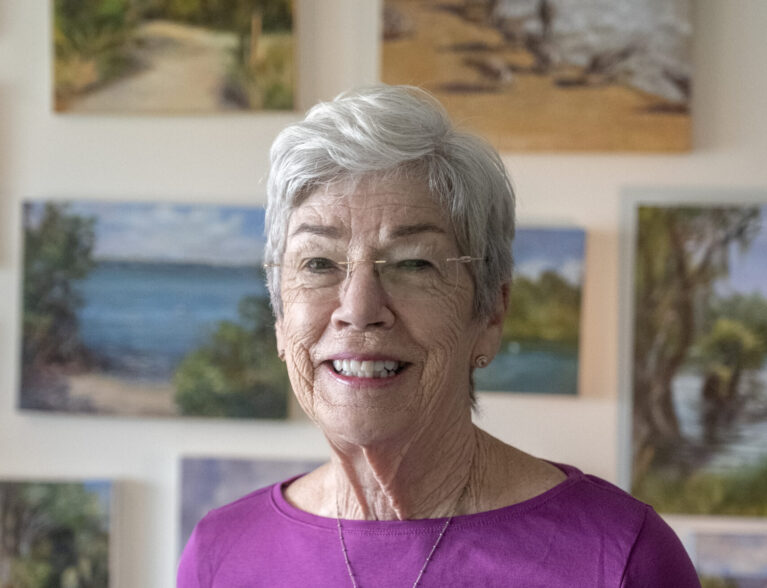
As a child, May Brandt recalls her mother telling her, “May, the only great artists are men.”
This despite the fact that there was art and music on both sides of the family, including her mother, whom she says drew beautifully, and a grandmother who was also a painter.
However, Brandt explains, they painted purely for pleasure.
The youngest of six, Brandt was born and raised in New York State and did her first painting at her mother’s knees.
“I was copying her. Imitating what she was doing,” says Brandt.
“To keep us quiet in church, when I was 4 or 5 years old, she would whip out an envelope and a pencil from her pocketbook and draw a little something, then say, ‘You draw.’”
Although her mother believed it wasn’t worth trying to have a profession as an artist unless you were going to be very superior, Brandt decided to give it a go.
“It took a lot of moral fortitude for me to say, ‘Well, I’m going to paint because I want to.’”
Her path took her out west, where she obtained a BA degree from Stanford University, majoring in ancient Greek with a minor in art.
“My original plan was to be a scientific artist for archeological expeditions. But I got married instead,” says Brandt.
She and her husband, a professor, moved all over the country, and in the early years Brandt taught preschool while their two boys were little.
Later, she considered becoming a speech pathologist because of her love of languages.
During one assignment, she was tasked with making phonetic cards, which she hand-painted with watercolor, pen and ink. Recognizing the convergence of ideas, she opted to explore language development with reading and art.
Eventually returning to New York, she earned a Master of Fine Arts from SUNY Albany and taught drawing for 20 years at the Sage Colleges of Albany, N.Y. Additionally, she earned a second master’s degree focusing on community psychology and art therapy, which she continues to use working as a volunteer with the memory impaired at care facilities.
An oil painter – she prefers water-based oils as they aren’t as shiny – Brandt’s early work primarily consisted of studio still life pieces, focusing on light and the surfaces of ordinary objects.
“I look for the special charm in ordinary things,” she explains. “I like to paint because it’s exciting and a challenge. I never know what is going to happen on my canvas and where my original idea is going to lead me.”
After moving to Vero Beach, Brandt got involved with several local plein air painting groups.
Part of the attraction, she says, is that you never know in advance what you’re going to paint.
As with the still-life works, what usually catches her eye are the lights and shadows.
“Most of my paintings start out of doors, and then they get finished indoors. The light changes and light and shadow are really, really important to me, as they are to most artists,” she says. As a result, she says it is essential to take photos, to capture that light.
“I’ve been thinking a lot about something I learned in high school English about the three themes that a lot of literature has. Man against nature, man against himself, and man against man,” says Brandt, commenting that it made her realize that “nature’s my thing.”
Many of her works have something manmade in them, such as the angles of machinery, interposed against a natural setting.
“There has to be something animate and inanimate. I like the play between something manmade, like architectural lines, and the biomorphic,” she explains, noting that she likes for the visual representation to tell a story.
She explains that when she paints, she often contemplates: “How can humankind be a better steward to nature?”
For example, referencing a painting of a tugboat carrying a backhoe to dredge the river, she explains that it represents man destroying nature. At the same time, a tractor at the Shining Light Garden [a local nonprofit that grows vegetables to feed the hungry] represents the positive interaction of man and nature.
Another example is a painting of waterlilies she is currently working on. In it, a bottle lies among the lily pads, a juxtaposition that demonstrates man’s carelessness.
Brandt says those of her paintings that show no traces of man “are the paintings that feel spiritual to me. I’m capturing something ordinary, but hopefully I’m making it seem memorable.”
Brandt prefers to sketch and then employs an underpainting, which she says is a crucial part of her process.
“A lot of the time I use orange to coat the canvas and then an orange and blue mixture to draw it and block in the darks and lights. If the underpainting is still wet, I can wipe away where I want it to be light,” she explains.
“The arrangement of the forms and shapes of the stuff that makes the composition, which includes the shapes of the light and the shadow, is the most important thing to me. Shape is more important than color, but color comes next.”
Brandt, who leans toward realistic impressionism, says she is inspired by contemporary landscape artists such as April Gornik and Vija Celmin.
“There’s usually a truth to the form in impressionism. If you look back at the French impressionists who started it all, there is a validity of form.”
There is also often humor in her work, with titles such as “Little Toot on the Indian River” and “11 Pipers Piping and One Leaving the Scene.”
“As you get older, it’s the one saving grace if you can still see the funny side of things.”
Brandt is a member of the Vero Beach Art Club and the Cultural Council of Indian River County, where she frequently shows her work through its Art in Public Places initiative. She has won numerous awards in juried shows, most recently the VBAC Art by the Sea exhibition at the Vero Beach Museum of Art, as well as the Environmental Learning Center.
Photos by Joshua Kodis
- May Brandt

